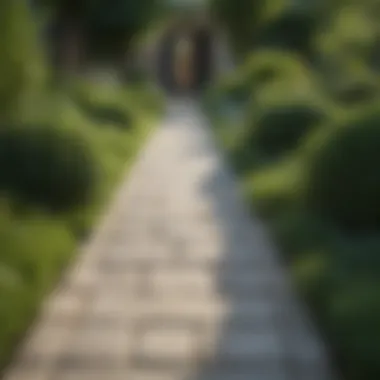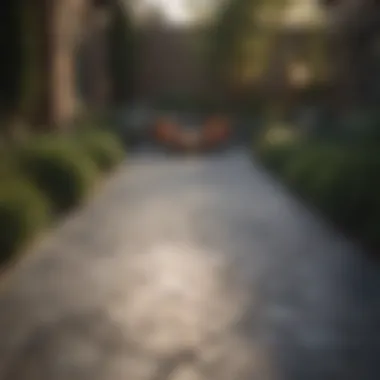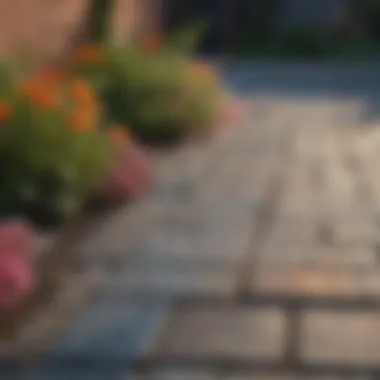Creative Paver Designs for Your Garden


Intro
Pavers can work wonders for garden spaces. With the right approach, they can be both functional and visually captivating. Homeowners and gardening enthusiasts often find themselves grappling with how best to create a welcoming outdoor environment. So, where do you start? Let’s dive into innovative ideas that incorporate pavers, and how these elements can transform your garden into something special.
Design Inspirations
Trending Styles
When considering design inspirations, it’s crucial to stay in tune with trending styles. Contemporary gardens increasingly lean towards clean lines, minimalism, and eco-friendliness. In settings where space is at a premium, permeable pavers are becoming more popular. These allow water to seep into the ground, reducing runoff and providing a sustainable option.
Another trend is the use of geometric patterns. For instance, arranging square pavers in a herringbone pattern can add a dynamic look while guiding the eye through your garden. Think about mixing different materials, too. Wood borders alongside stone pavers might add depth and texture.
Color Palettes
When it comes to color, the choices can be as varied as your imagination. Earthy tones like terracotta and slate are classic, perfect for a rustic feel. However, don’t shy away from bolder colors to make your garden pop. A vibrant blue or deep green can provide a striking contrast to the natural greens in your garden.
Certain combinations can evoke specific styles. For example, black and white pavers can create a modern contrast, while softer pastels can enhance a more whimsical design. Remember to consider the surrounding vegetation to create a harmonious palette. A cohesive look can often result in an inviting and well-thought-out outdoor space.
"Blending the right colors not only enhances the beauty of your garden but also complements the overall architecture of your home."
Maintenance and Upkeep
Seasonal Maintenance Checklist
Pavers may be low maintenance compared to other materials, but they still require some attention. Here’s a quick seasonal maintenance checklist to keep your garden looking spick and span:
- Spring: Inspect gaps for weeds, clean debris, and pressure wash stains.
- Summer: Keep pavers free from organic matter that can cause discoloration. Regularly sweep to prevent buildup.
- Fall: Rake leaves, check for shifts in the pavers, and apply sealer if necessary.
- Winter: Remove snow and ice carefully to avoid cracking.
Cleaning and Organization Tips
Routine cleaning is key. Consider using a gentle detergent mixed with water for regular cleans, as harsh chemicals might damage the surface. A soft brush will get into the grooves without causing any scratches.
For organization, maintain a clear path through your garden by eliminating clutter. Neat boundaries created with pavers can guide visitors and keep the space looking tidy.
Using pavers to create organized sections within your garden can minimize confusion. Whether it's a pathway, patio, or seating area, clear definitions and well-maintained edges can make a vast difference.
Preface to the Use of Pavers in Gardens
When one thinks of enhancing outdoor spaces, the role of pavers often slides under the radar. Yet, this seemingly simple element holds a treasure trove of potential. From defining paths to providing functional patios, pavers are far from just a practical choice; they can also create a visually appealing environment. Incorporating pavers into garden designs can transform the ordinary into the extraordinary, elevating not just aesthetics but also the usability of spaces. In this article, we delve into the importance of using pavers, highlighting noteworthy benefits and considerations, making pavers not just a choice but a compelling decision for homeowners and design enthusiasts alike.
Understanding Pavers and Their Benefits
Pavers come in a variety of materials—natural stone, concrete, clay brick, and permeable options—each offering unique advantages. For instance, they provide durability and the capacity to withstand weather elements, avoiding wear and tear over the years. Using pavers can also lead to a reduction in yard maintenance. Unlike traditional grass lawns, a well-designed paved area demands less upkeep and can help control mud, making it ideal for high-traffic zones.
Moreover, the installation of pavers allows for innovative drainage solutions, particularly useful in areas prone to flooding or pooling. The permeable pavers, in particular, promote groundwater recharge, which is beneficial for the local ecosystem.
In summary, the benefits of pavers encompass:
- Durability: They resist cracking and breaking compared to other surfaces.
- Versatile Design: Availability of numerous styles and colors that can complement any garden or patio.
- Low Maintenance: Less frequent weeding compared to soil-based landscaping and simple to clean.
- Drainage Efficiency: Particularly with permeable pavers, they assist in managing rainwater effectively.
The Versatility of Pavers in Landscape Design
The beauty of pavers lies in their unparalleled versatility. One can see them fitted elegantly in various styles, accommodating both modern minimalism and traditional charm. They can mark out pathways that lead through garden beds or create inviting patio spaces for outdoor gatherings. Pavers can be used creatively to establish zones within a garden, seamlessly defining areas for relaxation and play.
Additionally, the material allows for flexibility—shapes and arrangements can be tailored to suit personal preferences, whether it’s a circular fire pit area or straight-cut lines leading to the home. The visual aspects can be further accentuated with the addition of colorful mosaics or patterned arrangements that draw the eye and emphasize design intent.
To highlight their adaptability:
“The only limit to paver design is your imagination.”
Using pavers can be tailored to serve multiple functions. Whether it's a walkway through lush vegetation, a stylish border around garden beds, or an integrated cooking space, the choices are boundless. This ensures an outdoor space can be created that looks cohesive and harmonizes with nature, something that many homeowners desire. Their role in landscape design is undeniably significant and will continue to grow as our love for outdoor living evolves.
Types of Pavers Available for Garden Use
When it comes to enhancing a garden, the choice of materials often sets the stage for the overall aesthetic and functionality. Pavers, in particular, serve as both a practical surface and an artistic element, adding character to outdoor spaces. Understanding the different types of pavers is crucial, as each type comes with unique characteristics, benefits, and considerations that can effectively complement any garden design.
Natural Stone Pavers
Natural stone pavers, sourced from the earth’s crust, lend a timeless appeal to gardens. These include materials like granite, limestone, slate, and sandstone. One of the key advantages of natural stone is its durability; it can withstand heavy foot traffic and harsh weather without losing its elegance. Beyond functionality, the organic veins and textures of these stones can create stunning visual contrasts in any garden layout.


However, it’s worth noting that natural stone can be on the pricier side, both in terms of material and installation. Homeowners should also consider the maintenance aspect—some stones may require sealing to prevent staining and weathering. Ultimately, if a homeowner is aiming for a sophisticated look while prioritizing durability, natural stone pavers can transform a simple garden path into an inviting journey through lush greenery.
Concrete Pavers
Concrete pavers are by far one of the most popular choices for gardens, mainly due to their versatility and affordability. They come in various shapes, colors, and sizes, allowing for limitless design possibilities. Whether you are creating a modern patio or a rustic pathway, concrete pavers can fit the bill.
Benefits of concrete pavers include:
- Cost-effective: Generally less expensive compared to natural stones.
- Durability: Resistant to cracking and fading, offering long-lasting performance.
- Customization: Can be stained or textured to mimic other materials, like stone or brick.
Despite their advantages, some homeowners may worry about the aesthetic appeal of concrete. However, innovative design techniques can elevate this material from mundane to magnificent, making it suitable for any garden environment.
Clay Brick Pavers
Clay brick pavers bring a distinct, earthy charm to gardens. They have been a classic choice for centuries, and for good reason. Their rich, warm tones and varied textures create a cozy atmosphere, perfect for garden pathways and patios.
These pavers also offer certain benefits:
- Eco-friendly: Made from natural materials, they are an environmentally responsible choice.
- Aging beautifully: Clay bricks develop a unique patina over time, further enhancing their cultural and aesthetic value.
- Strength and stability: They have excellent compressive strength, making them suitable for high-traffic areas.
However, one drawback to keep in mind is that clay bricks can absorb moisture, which might lead to cracking in colder climates. Careful planning is essential, but with the right treatment, they can create an enduring charm in a garden setting.
Permeable Pavers
Permeable pavers are gaining traction as eco-conscious landscaping solutions. These innovative pavers allow water to infiltrate and drain through their surfaces, which significantly reduces runoff and erosion—an aspect increasingly important in sustainable design practices. For homeowners aiming to maintain a greener footprint, permeable pavers provide a chance to be ecologically responsible without sacrificing style.
Important features include:
- Environmental benefits: Helps manage stormwater and reduce urban heat effects.
- Versatile applications: Suitable for patios, driveways, and even walkways.
Despite their environmental perks, proper installation is critical to ensure the system works effectively. This may entail higher initial costs due to the need for expert labor and specific soil preparations. Nonetheless, the benefits far outweigh the costs, making permeable pavers a forward-thinking choice for modern gardens.
The right selection of pavers not only enhances the visual appeal but also contributes to the overall sustainability of your garden design.
Design Concepts for Gardens Utilizing Pavers
In the world of garden landscaping, pavers stand as a versatile foundation that can support a multitude of design concepts. By incorporating pavers, homeowners can create outdoor spaces that are both functional and visually appealing. Pavers serve not only as a practical solution for paths and patios but also as a decorative element that can elevate the overall aesthetic of the garden. Whether one dreams of a serene sanctuary or a vibrant hosting area for guests, design concepts centered around pavers lay the groundwork.
The flexibility offered by pavers enables various configurations and textures that can make a garden come alive. From uniform patterns to irregular shapes, pavers help to harmonize the natural beauty of plants and flowers with human-made structures. Each design choice impacts not just the look but also the usability of the garden, making it crucial for homeowners to think carefully about how pavers fit into their vision.
Walkways and Pathways
Creating walkways and pathways using pavers can dramatically improve both the functionality and appeal of a garden. These routes guide visitors through the landscape, inviting them to explore beautiful flora while maintaining a clean and accessible environment. For instance, pathways made from natural stone pavers can create a rustic charm, blending seamlessly with the surroundings. Alternatively, brightly colored concrete pavers can add a modern twist, drawing attention and providing a contemporary edge.
- Considerations for Pathway Design:
- Match the color and texture of the pavers with plants and architectural features.
- Ensure that the pathways are wide enough for comfortable navigation.
- Plan for drainage to avoid water pooling, especially in wetter climates.
Patios and Sitting Areas
Pavers offer endless possibilities for creating inviting patios and sitting areas. By selecting larger concrete or clay brick pavers, one can establish a solid base for outdoor furniture and gatherings. The adaptability of pavers allows for varied designs, fitting both sprawling terraces and compact urban balconies. An alternative is to use permeable pavers, which can create a more eco-friendly option as they allow rainwater to seep through.
- Tips for Patio Layouts:
- Use different paver types to define zones, such as dining and lounging spaces.
- Consider incorporating a pergola or umbrella for shade, enhancing comfort.
- Lighting elements can make these areas usable after sunset, cultivating a cozy atmosphere.
Fire Pits and Outdoor Kitchens
Integrating pavers around fire pits or outdoor kitchens creates a cohesive space for entertainment and relaxation. Installing heat-resistant pavers can ensure safety while enhancing visual appeal. A circular arrangement of pavers around a fire pit can invite intimacy, turning cold evenings into warm gatherings. For outdoor kitchens, durable pavers provide a solid work surface while also helping with drainage and preventing mud.
The right paver choice can transform ordinary outdoor cooking into a culinary experience.
- Design Ideas:
- Create an open-air kitchen with paver counters and bar areas to combine cooking and socializing.
- Place comfortable seating around fire pits for gathering and storytelling.
Garden Borders and Edging
Incorporating pavers as garden borders and edging can delineate different areas within a garden effectively. This design concept can help define plant beds, pathways, and even highlight specific flora. Pavers can be used either as a raised edge or set level with the ground, depending on the visual impact desired. Borders made from pavers can also serve practical purposes, such as preventing spreading of grass or mulch.
- Benefits of Using Paver Edging:


- Creates visual clarity in the garden layout.
- Reduces maintenance by keeping mulch and soil contained.
- Offers a touch of sophistication to the garden's overall design.
In summary, the integration of pavers into garden design provides homeowners with a wealth of options for creating engaging outdoor spaces. From practical pathways to elegant patios and functional borders, pavers enhance not just the beauty of a garden but also its usability. Each choice made in design contributes to a unique expression of personal style and enhances the outdoor experience.
Integrating Vegetation with Paver Designs
Integrating vegetation with paver designs is akin to weaving a vibrant tapestry where each thread plays its part. The harmonious balance between the hard surfaces of pavers and the lushness of plants creates an inviting environment, enhancing both the aesthetic and functional aspects of garden spaces. By thoughtfully incorporating green elements, homeowners can transform their outdoor areas into personalized sanctuaries, all while promoting biodiversity and sustainability.
Choosing Plants that Complement Pavers
When selecting plants to complement pavers, there are many considerations to keep in mind. Color, texture, and growth habit all come into play. For instance, pairing gray or beige concrete pavers with purple lavenders can create a striking contrast that captures the eye. Meanwhile, plants with broad leaves, like hostas, can soften sharp edges of pavers, creating a gentle transition that feels less harsh.
- Drought-tolerant options: Succulents and ornamental grasses not only thrive in dry conditions but also blend beautifully with various paver styles.
- Low-growing ground covers: These can nestle in crevices between pavers, making for a lush yet unobtrusive carpet of greenery. Creeping thyme, for example, offers a pleasant aroma when stepped on.
It's essential to match the plants' requirements with the microclimates created by the paver installation. Sun-loving plants flourish in areas with maximum sunlight exposure, while shade-tolerant varieties are best suited to those spaces shaded by taller garden structures or nearby trees. Choosing the right plants ensures a low-maintenance garden that provides ongoing beauty.
Creating Green Spaces Among Pavers
Crafting green spaces among pavers is a clever way to break up hardscapes and invite tranquility into your garden. Implementing pockets of dirt or planting beds can introduce a natural rhythm into the landscape. Consider framing a paver patio with perennial beds filled with bright flowers that bloom throughout the seasons. They provide not just visual splendor but also butterflies and bees, creating a bustling ecosystem.
- Use of planters: Elevated planters can be a game changer. They not only function well but also add a vertical dimension to the space, drawing the eye upward. Herbs, such as basil or rosemary, can thrive here as an aromatic addition to outdoor cooking areas.
- Interspersing greenery: Place pavers in a staggered format or on a diagonal to allow patches of soil to peek through. This not only makes the hardscape more dynamic but offers space for vegetation to grow.
- Water features: Incorporating small fountains or ponds in the mix can enhance the green space while creating a soothing atmosphere.
Using Pavers as a Base for Vertical Gardens
Vertical gardens are all the rage, and using pavers as a base can set the perfect foundation. By building a sturdy framework against walls or fences, homeowners can explore various climbing plants such as clematis or ivy. Pavers can provide a solid ground on which to place planters or trellises, encouraging plants to ascend while saving precious ground space.
- Staggered paver height: Creating different levels with pavers enhances the visual interest of the garden. This design can also accommodate a variety of plants, allowing for creative layering.
- Irrigation systems: Integrating drip systems with vertical gardens ensures that plants receive adequate moisture without excessive watering, reducing maintenance burdens.
Incorporating these design elements into your garden not only beautifies the area but also significantly enhances the utility of paver features. Ensuring an interplay between vegetation and hardscapes can elevate a simple garden into a sophisticated landscape while nurturing the environment.
Practical Considerations for Paver Installation
When it comes to creating a stunning garden space with pavers, understanding the practical considerations for installation is a game changer. The effectiveness and longevity of your paver project depend largely on how well you prepare and execute the installation process. Getting it right from the get-go not only enhances the garden's aesthetic but also ensures it can withstand the elements, wear, and tear that come with time.
Preparing the Ground for Paver Laying
Before laying down any pavers, ensuring that the ground is adequately prepared is crucial. This initial step can make or break your entire project. Start by removing any existing vegetation, rocks, or debris from the area where you intend to install the pavers. Once cleared, it’s important to level the ground as much as possible. Uneven terrain can lead to settling issues down the line, so don’t skimp on this part. Use a compactor or roller to tamp down the soil, creating a solid base.
Here’s a quick checklist:
- Remove unwanted plants and rocks.
- Level the ground and fill in low spots.
- Compact the soil to eliminate air pockets.
- Establish proper drainage to direct water away from the paver area.
Techniques for Proper Installation
Now that the ground is prepped, moving on to the installation techniques is essential. There are a few methods to consider, with the most common approach being the dry method. For this, lay down a base layer, typically a mix of sand and gravel, before placing the pavers. The sand helps to level the pavers and provides a cushion to minimize shifting.
When beginning with the pavers, start from a straight edge, like a wall or driveway, and work your way outward. Make sure to leave small gaps between each paver to allow for expansion and any potential shifting. If you’re using permeable pavers, remember they should be properly spaced to promote drainage. Here are some more detailed steps to follow:
- Lay the base of sand and gravel evenly.
- Place the pavers tightly together, maintaining uniform joints.
- Tap them into place lightly with a rubber mallet to ensure they're level.
- Fill the joints with sand once all pavers are laid, sweeping off any excess.
Tools Required for the Job
Having the right tools can make the difference between a smooth installation and a frustrating experience. Here’s a list of essential tools you’ll need:
- Shovel and Rake for moving and leveling soil.
- Compactor to compress the ground.
- Rubber Mallet for tapping pavers into alignment.
- Paver Leveling Tool or a String Line to ensure straight edges.
- Broom for cleaning up sand and debris after installation.
- Screed Board to level sand for a flat surface.
"Proper preparation and quality tools can elevate your paver project from mediocre to magnificent."
By paying close attention to the practicalities of paver installation, you set the stage for a beautiful and enduring outdoor space. Each of these steps ties into the overall success of your garden design, creating a flourishing environment where beauty meets function.
Maintenance of Paver Gardens
Maintaining paver gardens is not just a chore; it's an essential aspect of ensuring that your outdoor space remains inviting and functional over the long haul. Proper maintenance can prevent issues that might ruin the aesthetics of your garden, such as weeds creeping through or the pavers themselves degrading over time. Plus, regular upkeep can significantly extend the lifespan of your pavers, making your investment worthwhile.
Being proactive about maintenance can save you time and money in the long run. Just picture this: a well-kept garden with charming pavers, free from the chaos of tangled weeds and mossy growth. The delightful sound of a family gathering on your patio brings a sense of pride, knowing you cared for this space meticulously. Let’s walk through some key components of paver garden maintenance.
Cleaning and Repairing Pavers
Keeping pavers clean is crucial to maintaining both their appearance and functionality. Over time, dirt can accumulate, leading to discoloration. Simple tasks like power-washing the surface can do wonders. This method heats water, blasting all that muck away and restoring the paver's original charm.
Also, sometimes you might find a paver that’s cracked or uneven. Here’s where a hands-on approach comes into play.


- Inspect regularly - make it a habit to walk the paths and check for issues.
- Replace damaged pavers - sourcing the same style ensures a seamless look.
- Seal the pavers - this protects against stains and moisture.
"A little cleaning goes a long way in maintaining that gorgous garden look day in and day out."
Weed Control and Prevention
Weeds have a knack for popping up in the most unexpected places, and garden pavers are no exception. With the right strategies, you can keep them at bay. Here are a few methods:
- Polymeric sand: This special sand fills gaps and hardens, discouraging weed growth when wet.
- Landscape fabric: Placing this beneath your pavers can act as a barrier against weeds.
- Regular weeding: Manual removal of weeds helps keep your paver surface clean. Timing is key here; catching them early avoids bigger headaches later.
It might seem daunting at first, but building a habit of weed management makes it much easier. Remember, a weed-free paver garden not only looks better but also helps preserve the integrity of your paver structure.
Seasonal Care for Paver Gardens
Different seasons bring their unique arrays of challenges for paver maintenance. Each change in weather requires some thoughtful adjustments in your care routine.
- Spring: After winter, it’s time for a deep clean. Removing any debris that’s gathered can prevent stains and moss growth.
- Summer: While we all love the sun, don’t forget to check for cracks or shifting pavers caused by heat. Regular watering for nearby plants helps maintain moisture without flooding.
- Fall: With leaves falling, raking them up prevents stains as well as slipperiness. Also, if snow hits in winter, shoveling it off the pavers prevents salt damage that can ruin their look.
- Winter: Applying ice-melt safely is key. Products high in salt can deteriorate the pavers, so always look for alternatives.
By following these tips season by season, you’ll keep your paver garden looking sharp year-round. A little foresight and effort can transform your garden from a neglected patch to a respected sanctuary.
Case Studies: Successful Paver Implementations
Here in this section, we explore some real-world examples of how pavers have been used creatively to enhance outdoor spaces. Case studies are vital for understanding the practical application of concepts discussed previously in the article. They provide tangible evidence of paver versatility, design efficiency, and the transformative impact on gardens. These real-life inspirations reveal how pavers can bridge aesthetic appeal and functional use, serving as both a foundation and a focal point for outdoor design.
Urban Rooftop Gardens
Urban rooftop gardens are becoming quite popular in cities around the globe, and for good reason. They offer a personal slice of nature amidst towering skyscrapers. Pavers can play a significant role here. For instance, in Manhattan, a rooftop garden utilized large-format, textured concrete pavers arranged in a herringbone pattern, which not only looked striking but also provided an anti-slip surface. This design approach offered a sophisticated yet practical solution, letting urban dwellers enjoy their spaces without the worry of safety during rain.
The benefits extend beyond mere aesthetics; these paved surfaces help with water drainage, melding form and function seamlessly. Additionally, the selection of permeable pavers allows for effective rainwater management, reducing the burden on municipal systems. A rooftop garden can turn into a sanctuary, providing a relaxing environment for social activities.
Community Gardens with Paver Features
Community gardens offer a unique setting where neighbors can unite over shared gardening experiences. Here, pavers can facilitate organization and accessibility. For example, a community project in Seattle transformed an unused lot into a vibrant garden by installing paver pathways that led to various plant beds.
This not only allowed smooth access for visitors but also defined spaces efficiently. Moreover, colorful clay brick pavers were used to construct seating areas and gathering spots, transforming the ambience into a welcoming community hub where ideas and produce could be exchanged. The use of pavers in such gardens addresses practical concerns, such as weed control and maintenance, while enhancing the overall beauty of the shared space. The adaptable nature of pavers encourages creativity, letting community members leave their imprint on the design.
Private Residences with Innovative Paver Designs
Gardens at private residences present endless opportunities for customization with pavers. A home in Austin, for instance, showcases a patio integrated with garden borders using natural stone pavers. The homeowner creatively arranged the stones in varying layouts, creating a visually dynamic pathway that gracefully leads guests through lush greenery.
Using pavers this way highlights the individuality of the property while ensuring durability. By mixing textures and colors, the homeowner cultivated a rich outdoor experience that invites exploration. Pavers also provide the structural integrity for features such as raised flower beds or built-in seating areas, blending functionality with aesthetic charm. As one might say, it illustrates that beauty lies in the details; the careful selection of pavers allows homeowners to express their personal taste while enhancing the landscape.
"The right choice of pavers can make any outdoor space feel like an extension of one's home, blending comfort with style."
In summary, these case studies demonstrate that pavers are not just practical installations; they are a means to express creativity and functionality in garden design. From urban rooftops to community projects and unique private spaces, pavers stand out as a resourceful choice for enhancing gardens. Each case highlights how thoughtful design can create spaces that are inviting, accessible, and visually striking.
Epilogue and Future Trends in Paver Design for Gardens
As we wrap up our exploration into innovative garden ideas featuring pavers, it's essential to understand how the landscape of garden design is changing and evolving. The future trends in paver design reflect not only current aesthetic preferences but also a notable shift towards sustainability and technological advancements.
One of the key drivers in this sector is the growing demand for eco-friendly solutions. Homeowners, particularly those who are passionate about gardening and environmental stewardship, are increasingly looking for ways to minimize their carbon footprint. This lands us in the discussions around sustainable materials, which have gained significant attention in recent years. Not only do these materials help in conserving resources, but they also often come with more attractive price tags in the long run, creating a win-win scenario.
Another aspect to consider is how paver design is being enhanced with emerging technologies. With the advent of innovative manufacturing processes, the capabilities for customization in paver shapes, sizes, and colors are vastly improving. This means that the once simple idea of interlocking bricks can now evolve into something much more unique—a personalized statement piece in any garden.
"Incorporating pavers with smart technologies allows for gardens not just to look good but perform efficiently in terms of water management and energy consumption."
In summary, future trends in paver design will likely be shaped by a blend of sustainability and high-tech solutions. Homeowners and garden enthusiasts who stay ahead of these trends will not only beautify their spaces but also contribute positively to the environment, making informed choices—a notion that holds value in the ever-changing world of landscape design.
The Shift Towards Sustainable Materials
Sustainability is more than just a buzzword; it’s a necessity in today’s world. The shift towards sustainable materials in paver design involves using resources that are not only environmentally friendly but also durable and cost-effective. This includes materials like recycled concrete, reclaimed stone, and sustainably sourced natural stone.
Using recycled materials not only reduces waste but can also add a unique charm and character to garden spaces. It’s quite striking how these elements can create a distinctive landscape without compromising on aesthetics. Moreover, sustainable pavers often utilize permeable designs that allow rainwater to drain, minimizing runoff and promoting a healthier environment.
Benefits of sustainable materials in pavers include:
- Reduced carbon footprint
- Enhanced durability and longevity
- Unique aesthetic appeal
Emerging Technologies in Paver Creation
The evolution of paver design is strongly tied to advancements in technology. New production techniques allow for greater precision and creativity in how pavers are designed and utilized. For example, manufacturers are now able to create interlocking systems that not only simplify installation but also improve stability under various conditions.
Furthermore, technologies such as 3D printing are beginning to make waves in this field. Custom shapes and designs, which were once costly and complex to produce, are now increasingly accessible, offering personalizations that set gardens apart.
Some notable trends include:
- Smart pavers integrated with sensors to manage water flow
- UV-resistant materials for color longevity
- Customizable designs through advanced manufacturing techniques







